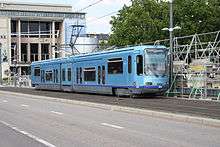Rouen tramway
|
| |||
| Overview | |||
|---|---|---|---|
| Native name | Métro de Rouen | ||
| Locale | Rouen, Normandy, France | ||
| Transit type | Tram | ||
| Number of lines | 2 | ||
| Number of stations | 31 | ||
| Daily ridership | 67,000 (2010)[1] | ||
| Operation | |||
| Began operation | 1994[2] | ||
| Operator(s) | TCAR | ||
| Technical | |||
| System length | 18.2 km (11.3 mi) | ||
| Track gauge | 1,435 mm (4 ft 8 1⁄2 in) standard gauge | ||
| |||
The Rouen tramway (French: Tramway de Rouen, known locally as "Métro de Rouen") is a network of two-line tramway in the city of Rouen, Normandy, France.
The tramway operates as one northern route with two southern branches to Saint-Étienne-du-Rouvray and Le Grand-Quevilly. The tramway's combined northern route runs through a 1.7-kilometre (1.1 mi) underground (subway) section in the Rouen city centre encompassing stations Joffre–Mutualité through Bouvoisine; the remainder of the tramway to the south of the underground portion runs on the road surface and on reserved track.
Modern tramway
In 1991, construction of a new tramway system began. This included constructing a 1.7-kilometre (1.1 mi) underground (subway) tunnel in the Rouen city centre encompassing Joffre–Mutualité through Bouvoisine stations along the tramway's route.
Rouen's tramway opened on 17 December 1994. In light of the fact that the new mode of transport technically is a light railway/tramway, inhabitants of Rouen and its suburbs have taken the habit of calling it the 'métro'. In September 1997 the tramway was extended to the Technopôle du Madrillet.[3]
At the Théâtre des Arts station downtown, transfers between the tramway and Rouen's three bus rapid transit lines (T1-T3) can take place. Transfers between the tramway and the SNCF railway line take place at Gare–Rue Verte station.
Technical data
- Length of the network : 18.2 km (11.3 mi)
- Number of stops : 31
- Number of tramcars : 28
- Tramcar capacity : 178
- Average commercial speed : 19.125 km/h (11.9 mph)
- Maximum speed: 80 km/h (50 mph)
- Daily traffic: 65,000 journeys
- Opening hours: 5:00am to 11:30pm
- Frequency of service: every 3 minutes (peak); every 20 minutes (off peak)
Rolling stock
Rolling stock is of light rail type; the GEC Alsthom Tramway Français Standard (TFS),[2] identical to those used on the Grenoble tramway (1987) and Paris Tramway Line 1.
In January 2010 Alstom was awarded a €90m contract to supply 27 Citadis 402 trams in 2011–2012 to replace the TFS cars.[2]
History
First generation tramway
The first tramway was steam hauled, opened in 1874 and was owned by Gustav Palmer Harding. The Compagnie des Tramways de Rouen (CTR) was created on 11 September 1878. Steam hauling stopped in 1884 due to rising costs and the ineffectiveness of the system, the tramways then were horse drawn.
On 19 June 1892 a funicular railway linking Rouen to Bonsecours opened. Two years later, in 1894, the decision to operate all tramways electrically was made.
A second company, the Compagnie Générale de Traction (CGT) was created in 1895 and opened lines to Bapeaume, Amfreville-la-Mi-Voie and Bihorel. The CTR electrifed its tramway network 22 March 1896 on time for Colonial Exposition of 1896, organised in Rouen.
The CGT and CTR were supplemented by a third tramway company, the Compagnie du Tramway de Bonsecours, which in 1899 opened a line from Rouen's Pont Corneille to Bonsecours. To reach Bonsecours, the line had to climb a steep ramp, reaching 60 mm/m (6%) and 80 mm/m (8%). This made the total length of network 38 km long. In 1906, a short lived line linking le Trianon to the Forêt du Rouvray opened, this closed in 1908.
In 1910, The CGT, the Compagnie du Tramway de Bonsecours merged into the CTR. Two years later, the tramway was extended to Bois-Guillaume. The last line was opened on 1 August 1915, this stretched between Rouen and Grand-Quevilly, its purpose was to link military camps to the city-centre. A fire broke out in the Trianon depot on 30 November 1921.
In 1930, the first bus line began operations between Place Beauvoisine and Cimetière Nord. The first tramway line closure occurred the same year and was replaced by buses.
The trolleybus made a discreet appearance in 1933 during tests, the first line opened in 1937 and linked Mont-Saint-Aignan to the city.
For six years, between 9 June 1940 and 20 April 1946, crossing of the River Seine was interrupted due to the World War II hostilities. The line to Amfreville was closed and replaced by buses in 1948.
On 28 February 1953, the last tramway line closed, followed in 1970 by the last trolleybus.
The tramway system was operated by three companies, all using 1,435 mm (4 ft 8 1⁄2 in) standard gauge tramcars.
Depots
The Compagnie des Tramways de Rouen (CTR) kept its rolling stock in three tramway depots;
- Trianon, situated on the south bank of the river Seine
- Bonsecours, situated at the top of the incline of the same name.
- Maromme, situated in the north of the city.
See also
References
- ↑ https://web.archive.org/web/20120504050608/http://sncfpassion.com/2011/02/07/le-metro-de-rouen/. Archived from the original on May 4, 2012. Retrieved December 7, 2012. Missing or empty
|title=(help) - 1 2 3 "Rouen orders trams to increase capacity". Railway Gazette International. 5 January 2010. Retrieved 2011-05-24.
- ↑ "Paris opening launches next round of French tram projects". Railway Gazette International. 1 August 1997. Retrieved 2011-05-24.
External links
| Wikimedia Commons has media related to Rouen tramway. |
- TCAR – official website (French)
- Rouen on UrbanRail.net (English)
- Rouen Seine valley Tourist Board's Website

